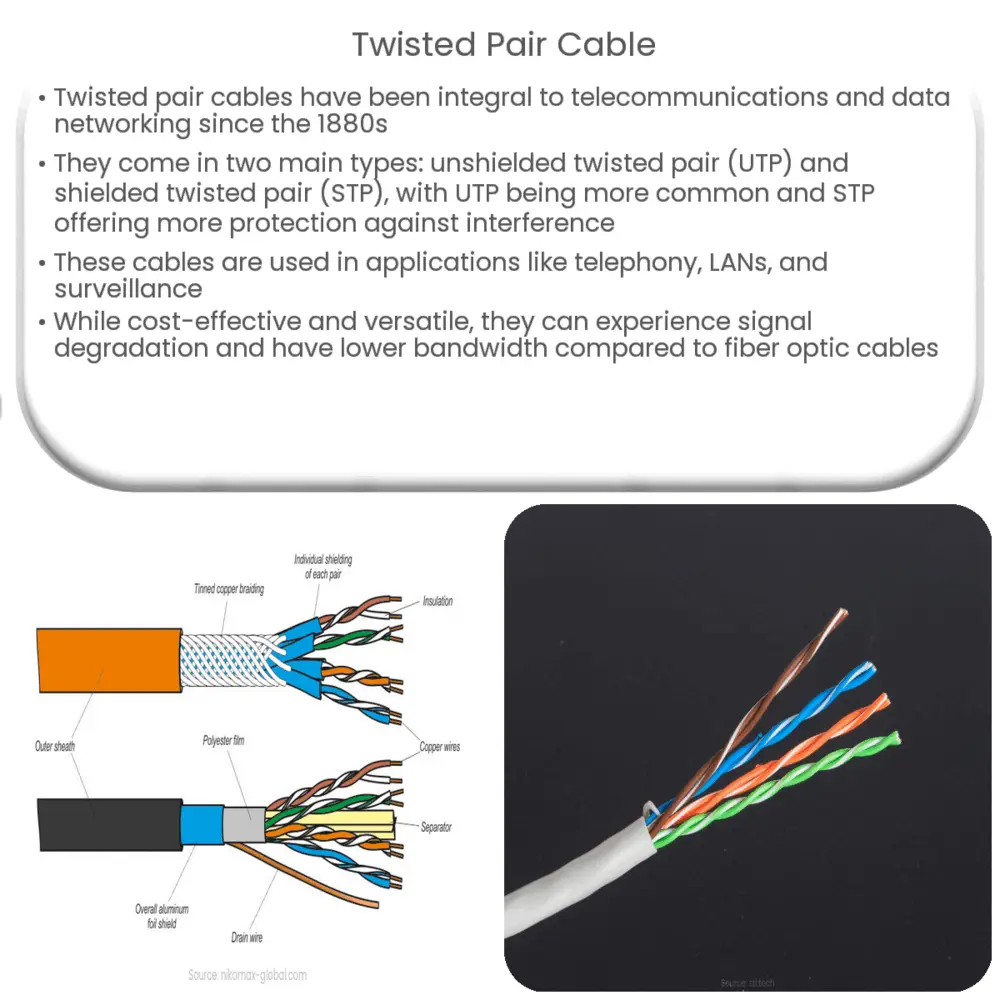Explore twisted pair cables, their history, types (UTP & STP), applications, advantages, and disadvantages in telecommunications and data networking.

Twisted Pair Cable: An Overview
Introduction
Twisted pair cable has been a staple in the world of telecommunications and data networking for decades. Known for its cost-effectiveness and versatility, it has become the go-to choice for many businesses and homes. In this article, we will take an in-depth look at twisted pair cable, exploring its history, types, and applications, as well as the advantages and disadvantages of using this popular cabling option.
History of Twisted Pair Cable
The concept of twisted pair cable dates back to the 1880s when Alexander Graham Bell discovered that twisting wires together could reduce interference and improve the quality of telephone signals. By the 1900s, twisted pair cables had become the standard for telephone installations, and their use quickly expanded to include data transmission for early computer networks. Today, twisted pair cables are ubiquitous in homes and businesses, connecting devices ranging from telephones and computers to security cameras and industrial equipment.
Types of Twisted Pair Cable
Twisted pair cables can be broadly categorized into two types: unshielded twisted pair (UTP) and shielded twisted pair (STP).
Unshielded Twisted Pair (UTP)
UTP is the most common type of twisted pair cable, characterized by its lack of additional shielding around the wires. UTP cables are made up of individual pairs of insulated copper wires twisted together, typically with a PVC outer jacket. The twisting of the wires helps to reduce electromagnetic interference (EMI) and crosstalk between the pairs. UTP cables are available in various categories, ranging from Cat 3 (used for voice applications) to Cat 6a (used for high-speed data networks).
Shielded Twisted Pair (STP)
STP cables feature an additional layer of shielding around each wire pair, or around the entire cable, to further reduce EMI and improve signal quality. This shielding can be made of metal foil, braided wire, or a combination of both. STP cables are often used in environments with high levels of electrical noise or where the cable runs are long, such as in industrial facilities or data centers. While they offer better protection against interference, STP cables are generally more expensive and less flexible than UTP cables.
Applications of Twisted Pair Cable
Twisted pair cables have a wide range of applications in both residential and commercial settings. Some common uses include:
- Telephone lines and Voice over IP (VoIP) systems
- Local Area Networks (LANs) for data transmission, such as Ethernet networks
- Security camera and surveillance systems
- Building automation and industrial control systems
Advantages of Twisted Pair Cable
Twisted pair cables offer several advantages that have contributed to their widespread use:
- Cost-effective: UTP cables are relatively inexpensive compared to other cabling options, such as fiber optic or coaxial cables. This makes them an attractive choice for budget-conscious organizations and homeowners.
- Easy to install: The flexibility and lightweight nature of twisted pair cables make them easy to install, even in tight spaces or around corners.
- Wide compatibility: Twisted pair cables are compatible with a large number of devices and networking standards, making them a versatile option for various applications.
- Scalability: As technology advances and data transmission speeds increase, new categories of twisted pair cables are developed to keep up with the demands, allowing users to upgrade their networks with minimal disruption.
Disadvantages of Twisted Pair Cable
Despite their advantages, twisted pair cables also have some drawbacks:
- Signal degradation: Twisted pair cables are susceptible to signal degradation over long distances. This can be mitigated by using higher-quality cables, but for very long distances, fiber optic cables may be a more suitable option.
- Electromagnetic interference: While the twisting of the wires helps reduce EMI, unshielded twisted pair cables can still be affected by interference from other electrical devices, which can lead to signal degradation or loss. Shielded twisted pair cables offer better protection against EMI but come at a higher cost.
- Lower bandwidth: Twisted pair cables generally offer lower bandwidth compared to fiber optic cables, which can limit their performance in high-speed data networks or other applications that require high data transfer rates.
Conclusion
Twisted pair cables have proven to be a versatile and cost-effective solution for a wide range of telecommunications and data networking applications. While they may not be the best choice for every situation, their ease of installation, compatibility, and scalability make them a popular option for many residential and commercial installations. By understanding the differences between unshielded and shielded twisted pair cables, as well as their advantages and disadvantages, users can make informed decisions when selecting the right cabling solution for their needs.

